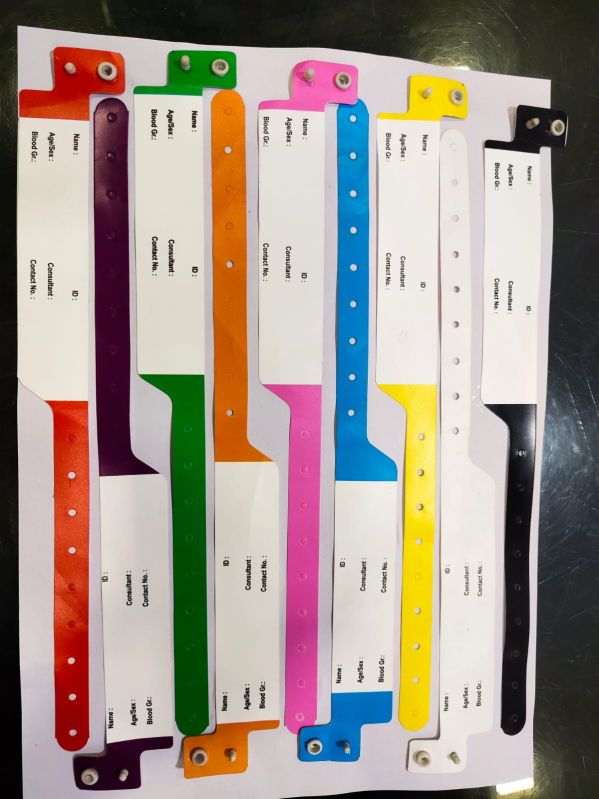Choosing the Right Components for Your Patient Identification Band: A Step-by-Step Guide
Choosing the Right Components for Your Patient Identification Band: A Step-by-Step Guide
Blog Article
Checking Out the Numerous Sorts Of Patient Identification Band Made Use Of in Clinical Facilities
In the elaborate world of health care, the essential function of Patient Identification bands commonly goes undetected. These bands, varying from simple paper wristbands to sophisticated RFID bands, create the backbone of Patient safety and security protocols, making certain precision in Patient Identification.
Comprehending the Relevance of Patient Identification Bands
While they might appear like plain accessories, Patient Identification bands play a vital role in clinical centers. These bands act as a vital tool for verifying Patient identification, avoiding clinical mistakes connected to misidentification. The bands typically show essential information such as the Patient's name, age, blood kind, and any kind of well-known allergies. They allow health care experts to swiftly access this crucial details, therefore facilitating punctual and precise clinical therapy. Patient Identification bands additionally help in streamlining administrative tasks, making sure precise record-keeping and billing. Despite their simplicity, these bands embody the principle of Patient safety, a keystone of high quality wellness care. Without them, the danger of medical errors, and as a result, Patient harm, might substantially increase.
Typical Paper Wristbands: Their Use and Limitations
Standard paper wristbands have been a staple in Patient Identification across numerous medical facilities. While their usage prevails, they harbor particular constraints that may influence their performance in Patient administration. This section will certainly concentrate on the extent of their application and the intrinsic disadvantages connected with their usage.
Paper Wristbands: Use Range
In the realm of Patient Identification, paper wristbands have actually long held a vital role. These bands are typically utilized in outpatient setups, where the Patient's stay is momentary. In spite of advancements in innovation, the humble paper wristband remains a economical and reputable remedy for Patient Identification in numerous healthcare circumstances.
Limitations of Paper Wristbands
Despite their widespread usage, paper wristbands are not without their drawbacks. In addition, paper wristbands typically do not have the technological abilities of even more modern-day options, such as barcoding or RFID chips, restricting their functionality to merely showing written info. Paper wristbands can create pain or skin irritability to some individuals, especially when put on for extensive periods.
Barcoded Wristbands: Improvements in Patient Identification
While Patient Identification has long been an essential aspect of health care, the advent of barcoded wristbands indicates a substantial jump ahead. These bands utilize the simpleness of barcoding modern technology, allowing for Patient info to be quickly scanned and accessed. They improve the speed and precision of Patient Identification, minimizing the threat of medical mistakes associated with misidentification. Barcoded wristbands are cost-efficient, simple to generate, and get rid of handwriting mistakes usual with hands-on systems. They are not without constraints. While they supply renovations over conventional bands, the barcode can become smudged or used, rendering it unreadable. Regardless of this, barcoded wristbands remain a necessary device in modern-day medical care setups, signifying the crossway of innovation and Patient treatment.
Radio Regularity Identification (RFID) Bands: an Action Towards Futuristic Health Care
The advancement of Patient Identification bands has actually caused the emergence of Superhigh frequency Identification (RFID) Bands (patient identification band). These innovative tools present essential benefits for healthcare centers, offering a much more efficient and technically progressed means of Patient Identification. The implementation of RFID in medical care is a substantial step in the direction of a much more futuristic approach to Patient management and safety and security
Understanding RFID Bands

RFID Bands: Key Advantages
Embracing a future where innovation and medical care merge, radio regularity Identification bands supply a number of crucial advantages. Mainly, these bands improve Patient safety and security by providing precise, rapid Identification, consequently reducing medical errors. RFID bands can store a substantial quantity of Patient data, consisting of case history and allergic reactions, enabling individualized treatment. They additionally enhance administrative jobs, as the automated information entry replaces manual procedures, enhancing efficiency and reducing paperwork. RFID bands use real-time monitoring of clients, vital in high-risk atmospheres such as surgical procedure or intensive care. Lastly, these bands are resilient and immune to environmental variables, making sure constant capability. On the whole, RFID bands represent a considerable development in Patient Identification modern technology, benefiting both patients and doctor.
Implementing RFID in Healthcare
As we enter a technologically helpful resources sophisticated period, the application of RFID bands in health care becomes significantly crucial. These bands supply a why not find out more seamless means to track and determine individuals, ensuring their safety and security and improving performance in treatment procedures. RFID bands supply many advantages over conventional Identification techniques. They can store a huge amount of information, consisting of the Patient's medical background and therapy plans, which can be conveniently accessed by doctor. This data assists medical professionals make informed choices regarding the Patient's therapy plan. In addition, RFID bands minimize clinical errors by supplying accurate Patient Identification, which is critical in avoiding misdiagnosis or wrong medicine management. Thus, the implementation of RFID bands is a considerable action towards improving Patient safety and healthcare shipment.

Color-Coded Wristbands: Assisting in Quick and Accurate Diagnosis
In the busy atmosphere of a clinical facility, color-coded wristbands have actually emerged as crucial devices for swift and precise Identification of an individual's medical problem. These wristbands, worn by patients, carry details colors that match to various clinical conditions or standings. This system is made to use prompt aesthetic signs to healthcare providers, boosting Patient safety and care top quality.
Techniques for Reliable Application and Monitoring of Patient ID Bands
Achieving optimal usage of Patient Identification bands necessitates a well-structured technique for their implementation and administration. The initial action entails training all wellness employees on the value of appropriately using and reading these bands. Healthcare facilities must systematize the usage of ID bands across all departments, making certain harmony and lowering disparities. Regular audits needs to be carried out to confirm adherence to plans and to correct any kind of variances. Patient education and learning is also important; patients need to comprehend the objective of the bands and the demand for their continuous wear. patient identification band. Finally, it's important to have a back-up plan in area, such as blog barcode scanning or biometrics, to make sure that Patient Identification is never ever compromised.
Verdict
Patient Identification bands are important in clinical centers to make sure safety and precision. Effective implementation and administration of these bands can considerably lower medical errors, enhance efficiency, and enhance general Patient treatment.
These bands, differing from straightforward paper wristbands to sophisticated RFID bands, develop the backbone of Patient security procedures, ensuring precision in Patient Identification.The advancement of Patient Identification bands has brought regarding the emergence of Radio Frequency Identification (RFID) Bands. Generally, RFID bands stand for a substantial improvement in Patient Identification innovation, benefiting both people and health care companies.
RFID bands lower clinical errors by supplying precise Patient Identification, which is important in stopping misdiagnosis or incorrect medication administration. Patient education and learning is additionally essential; patients must understand the objective of the bands and the need for their constant wear.
Report this page